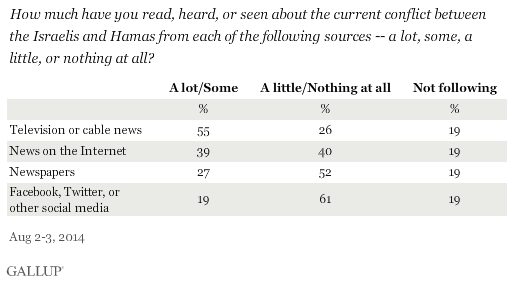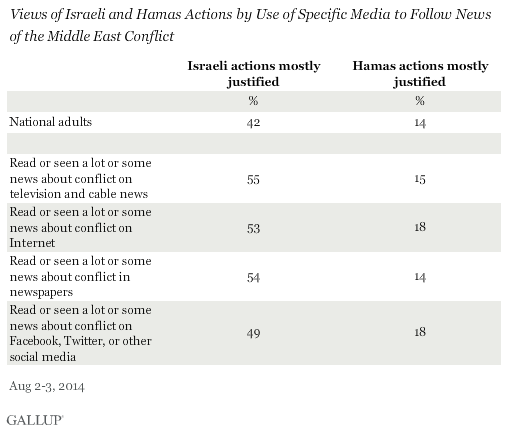PRINCETON, NJ -- Americans' views of the military actions of Israel and Hamas in the current conflict in Gaza have changed little over the past 10 days. The public remains closely divided over whether Israel's actions have been justified, but is mostly critical of Hamas' actions.

These results from Gallup Daily tracking interviews conducted Aug. 2-3 are also similar to what Gallup measured for another period of heightened Israeli-Palestinian violence in 2002. This stability suggests that Americans' underlying attitudes about the region may be anchoring their reaction to the Gaza conflict, even as raw images of the fighting and civilian casualties pour in.
Although the latest explosion of violence has been going on for nearly a month prior to the temporary cease-fire agreed to on Monday, Americans appear to be paying no more or less attention to the conflict now than they were in late July. Six in 10 say they are following the conflict "very" or "somewhat closely."
The advent of social media has changed the dynamics of the way news unfolds worldwide. Some observers have argued that this more real-time news, often including more graphic coverage of the fighting, destruction, injuries, and deaths in Gaza, could affect public opinion about the conflict.
The evidence to support that hypothesis is not strong. Not only is opinion little different now than it was during a similar 2002 conflict, but just 19% of Americans report using Facebook, Twitter, or other social media to follow news of the conflict "a lot" or "some," significantly lower than those who are using newspapers, the Internet, and in particular television (including cable) news.

The attitudes of those following the conflict on social media are only marginally different from the attitudes of those following the conflict using other sources of news and information, although many Americans may be exposed to multiple sources of news content.
Those who are paying closest attention to the conflict in general are more likely to say that Israel's actions are justified. It follows that the four groups who use each of the four sources of information are also more likely than the average respondent to say Israel's actions are justified. There is a slight tendency for those using social media to be less likely than those using other media to say Israel's actions are justified, but even among this group, the percentage is higher than the average of national adults. Those using the Internet and social media are slightly more likely to say that Hamas' actions are mostly justified, but these differences are again slight.

Implications
Despite the vividness of news and social media images emanating from the conflict in the Middle East, Americans' attention to the conflict and their attitudes about the actions on both sides have remained remarkably unchanged compared with almost two weeks ago, and also compared with results from the period of Israeli-Palestinian violence 12 years ago. This suggests that Americans may have responded to both crises in ways that reflect their basic attitudes toward Israel and the Palestinians rather than the specifics of either conflict. In general, Americans rate Israel much more favorably as a country than the Palestinian Territories, and are much more likely to say they sympathize with the Israelis than the Palestinians when asked to choose between the two sides.
Americans remain roughly divided on the issue of whether the actions of the Israelis against the Hamas are justified. While this is unchanged from previous updates, it is important to note that the pro-Israel sentiment on this measure is significantly below the percentage who routinely say that their sympathies are more broadly with the Israelis rather than the Palestinians in the Middle East.
Survey Methods
Results for this Gallup poll are based on telephone interviews conducted Aug. 2-3, 2014, on the Gallup Daily tracking survey, with a random sample of 1,019 adults, aged 18 and older, living in all 50 U.S. states and the District of Columbia.
For results based on the total sample of national adults, the margin of sampling error is ±4 percentage points at the 95% confidence level.
Interviews are conducted with respondents on landline telephones and cellular phones, with interviews conducted in Spanish for respondents who are primarily Spanish-speaking. Each sample of national adults includes a minimum quota of 50% cellphone respondents and 50% landline respondents, with additional minimum quotas by time zone within region. Landline and cellular telephone numbers are selected using random-digit-dial methods. Landline respondents are chosen at random within each household on the basis of which member had the most recent birthday.
Samples are weighted to correct for unequal selection probability, nonresponse, and double coverage of landline and cell users in the two sampling frames. They are also weighted to match the national demographics of gender, age, race, Hispanic ethnicity, education, region, population density, and phone status (cellphone only/landline only/both, and cellphone mostly). Demographic weighting targets are based on the most recent Current Population Survey figures for the aged 18 and older U.S. population. Phone status targets are based on the most recent National Health Interview Survey. Population density targets are based on the most recent U.S. census. All reported margins of sampling error include the computed design effects for weighting.
In addition to sampling error, question wording and practical difficulties in conducting surveys can introduce error or bias into the findings of public opinion polls.
View survey methodology, complete question responses, and trends.
For more details on Gallup's polling methodology, visit www.gallup.com.
